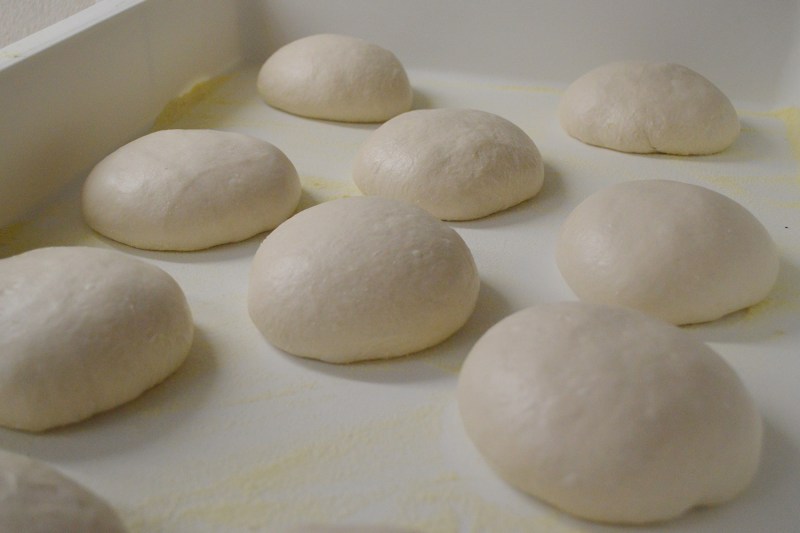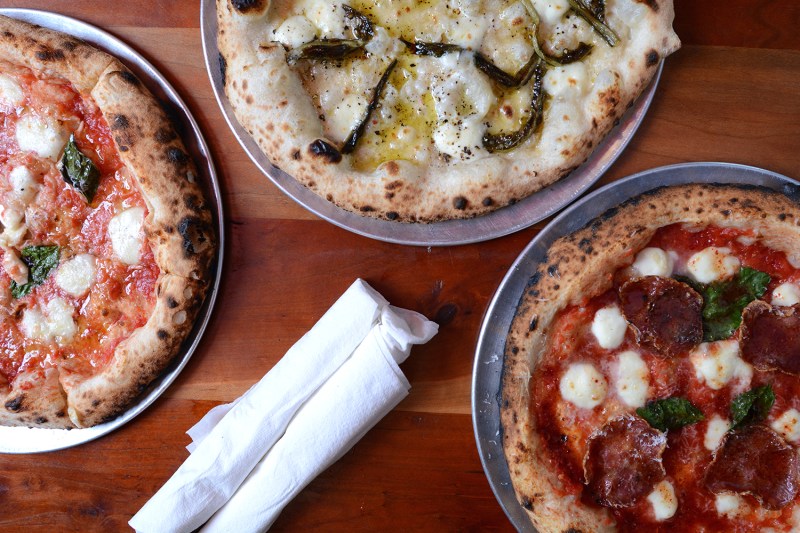Thanks to its enduring popularity, pizza proves a valuable target for trends. From off-the-wall toppings to pies designed for different meal periods (“breakfast pizza” and “dessert pizza,” anyone?), imaginative pizzaiolos always seek new ways to enhance and perfect this craved-by-many classic.
One highly influential trend in the pizza world involves gluten-free and gluten-sensitive crust options. Major pizza spots like Emmy Squared in Brooklyn and Lou Malnati’s in Chicago have added options to their menus for those seeking to escape the negative consequences of gluten, exploring dough alternatives designed to ease digestion.
Another pizzeria focusing on digestive comfort is Pizza Lupo, a lauded Neapolitan-style destination in Louisville, KY headed up by executive chef and co-owner Max Balliet (you can read more about Lupo here). At Lupo, Balliet crafts a flavorful dough in a mega-trendy way: by using slow fermentation. This process offers the dough an appealing tang while also making it easier to eat for folks with gluten sensitivities, and guests are responding with rave reviews.
We had the chance to chat with Balliet about his fermentation process and the benefits associated with these techniques, and here’s what he had to share with us.
The Manual: How and why do you ferment your dough?
Max Balliet: [When fermenting dough, you’re] trying to break down the sugars in the flour into carbon dioxide, and the gas brings leavening to your dough. And that’s what creates the structure — what I like to call the “crumb” — of the bread. The primary goal is to achieve a lightly textured, delicate interior… or, at least, that’s my goal. And the secondary product of fermentation is flavor. The longer your dough is exposed to fermentation, the more the flavors develop.

Our process is all about long fermentation, and we do it at room temperature, which is a huge challenge. When you ferment at warmer temperatures, it goes much quicker [making it harder to control]. The reason that we do room temperature is because we find that room-temperature fermentations develop more flavor than fermentations at cold temperatures. So we are attempting to ferment for as long as possible at about 66 degrees Fahrenheit. In order to do that, we have to use a very small amount of yeast. We use special, fresh yeast; it’s kind of an older version of instant or active yeast, and it’s specially designed for long, room-temp ferments. We let it go for 36 hours total, and that buys us a nice, controlled leavening. We get all of the lift that we’re looking for, but we also get the breakdown of those compounds that can make bread hard to digest, and we get the development of flavor.
TM: What type of flavor does fermentation bring to pizza dough?
MB: When you let dough ferment fully, you start to really experience it on a spectrum. The longer you let it go, the more sour it becomes, and the best example of that is sourdough bread. So that’s primarily the flavor you’re looking for when you’re differentiating between two doughs that have fermented at different intervals. The sourness is the biggest variable that you can affect with time. But what I like, instead of going full-force sour, is more of a balance. That way, there’s a bit of intrigue there. When that’s done properly, it gives you a dough that’s got complexity. That’s really what I’m looking for.
TM: Which pizza toppings match well with the more-flavorful fermented dough?
MB: The two main types of pizzas that we have at Pizza Lupo are red-based (tomato-sauce pizzas) and white-based (ricotta pizza). The tomato-based ones are all of our traditional ones, like margherita and marinara. When picking the tomatoes to use for the sauce, you want to take the acidity (or sourness) of your dough into consideration, because you’re gonna try to balance that with the acidity of the tomatoes that you use. So if you’re using an aggressive sourdough recipe for your pizza dough, I’d try to pick a more sweet tomato to pair with it. Our sourness is more subtle and subdued, so when we pick tomatoes for our sauce, I pick some with a higher acidity. The tomatoes and the dough are absolutely designed to complement each other. Everything after that…the mozzarella gives it richness and a creamy texture, the Parmigiano Reggiano gives you some umami and a bit of extra salt, and the basil gives you a fresh, vegetal, herbal flavor. So what we’re trying to accomplish is to balance all of the tastebuds.
“When you let dough ferment fully, you start to really experience it on a spectrum.”
To get the bitter flavor, we char our pizza dough in the oven. The oven runs at 900 degrees, and when it browns the pizza, it doesn’t do it the way that a traditional pizza oven would. It does it at such an intense temperature that it blisters it, and in the Neapolitan pizza world, we call those markings “leoparding.” You’ll see a total coverage of black spots around the edge of the crust. I consider that even a topping of the pizza…a component of the overall composition of what the pizza is, and all of these elements are taken into consideration when creating the balance. And other ingredients, like soppressata — we do a hot honey and soppressata pizza called “Sting Like A Bee”- once you have the base and it’s balanced, you can put a lot of stuff on it. When we’re talking about how to choose toppings, the base pizza: tomato sauce, cheese, basil, olive oil – has been chosen for balance. That’s why my favorite pizza is a margherita because it’s all of those components in perfect harmony with each other. You don’t need extra toppings to make it better…it’s perfect as it is. But we do offer toppings like soppressata and honey and house-made Italian sausage. I hope that customers can appreciate the Margherita for its perfect simplicity, but when they want to try something new, we’ve got stuff to complement it that doesn’t interfere with what’s going on on the base level, but can add to the experience.
TM: How does fermentation make your pizzas easier for gluten-sensitive people to digest?
MB: Basically, the idea is that with Old World styles of making dough and bread, people in general say that they’re easier to digest and that they don’t have as many problems with them. When I started making bread and pizza and started reading about how long fermentations develop flavor, I went after it because I’m obsessed with flavor and texture. As a cook, these are the things that are important to me.

Then, I read an article a few years ago about how a slow fermentation both develops flavor and breaks down the protein strands that are the elements responsible for triggering gluten insensitivity in people. And I thought: “That makes perfect sense to me. That’s why nice artisan breads are easier to digest as well as being more delicious.” That’s why no one talked about gluten a hundred years ago. Because we didn’t have the problems we have now, with our focus on shelf-stable products and fast-acting yeasts [that trigger digestive problems].
TM: Has the gluten-friendly nature of your pies proven a helpful marketing hook for Pizza Lupo?
MB: Absolutely. It’s something that we try to educate people about as much as we can. It can be hard (because the science involved is boring to a lot of people), but we’ve had lots of customers come up to us and tell us that they don’t normally eat bread, but that they eat our pizza because they can digest it more easily. And that’s when we tell them “Oh, it’s because of our fermentation…”
“A life without eating bread is ridiculous.”
So yeah, it’s slow-going, because it’s not the easiest thing to get people excited about. But I feel like if you really have problems with gluten, which it seems like a lot of people do, it’s worth a shot. Because to me, a life without eating bread is ridiculous. So if you’re having trouble digesting it, maybe try changing the types of bread that you’re eating, instead of just assuming that bread is somehow the enemy.
TM: Can you imagine fermented pizza dough becoming a more widespread trend?
MB: Technically, all pizza dough is fermented. To call it “fermented dough” can sound misleading because all dough is fermented [to some extent]. The easiest way for people to [understand what we do] is [to think about] sourdough. If you call a bread “sourdough,” it becomes obvious that there’s some kind of difference in the technique. Personally, I don’t really like calling my pizza “sourdough,” because sourness isn’t totally what I’m after. What I’m after is digestibility and enough sourness to give it depth of flavor; if [the dough] was too sour, it would unbalance the pizza. So I wish that there was a different thing to call it, because the concept would be very marketable. You could say “this has been responsibly fermented’ or something like that. I think what it’s gonna take is more public awareness and people coming to understand that they’re not allergic to bread; they’re allergic to [poorly-made] bread.



